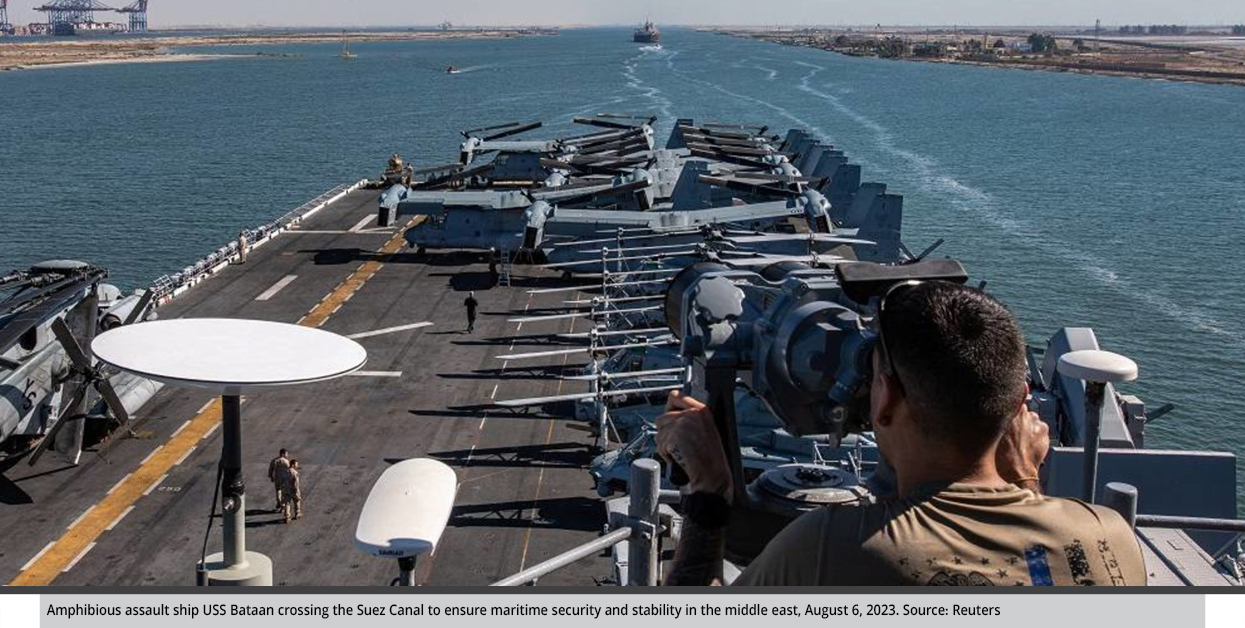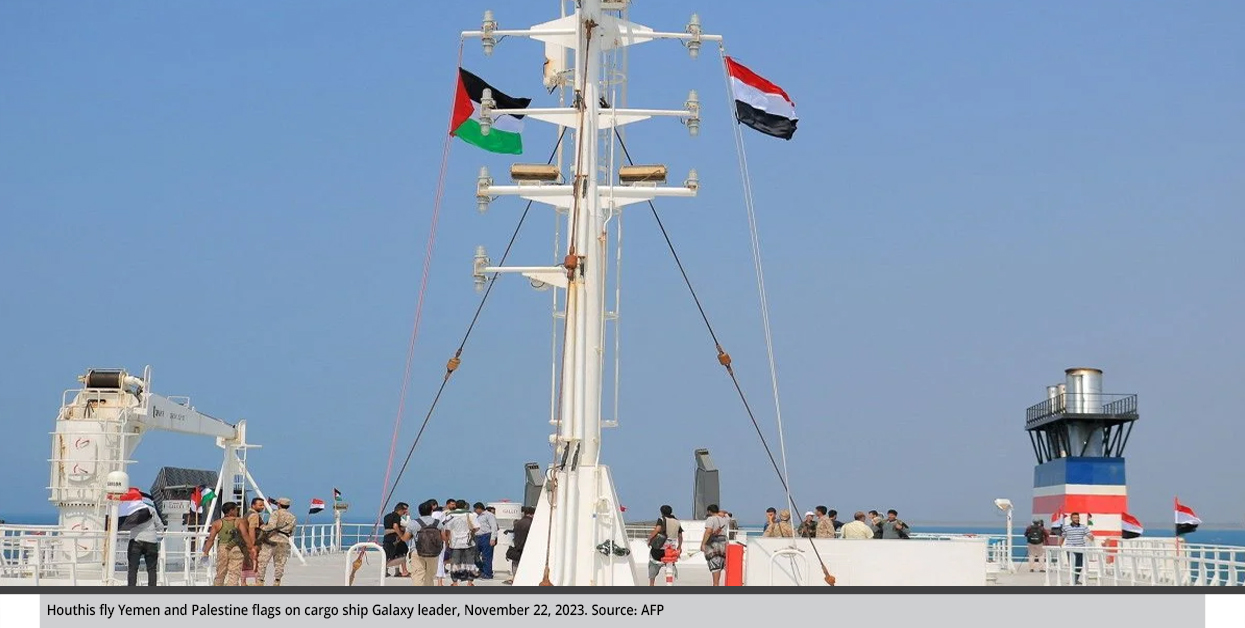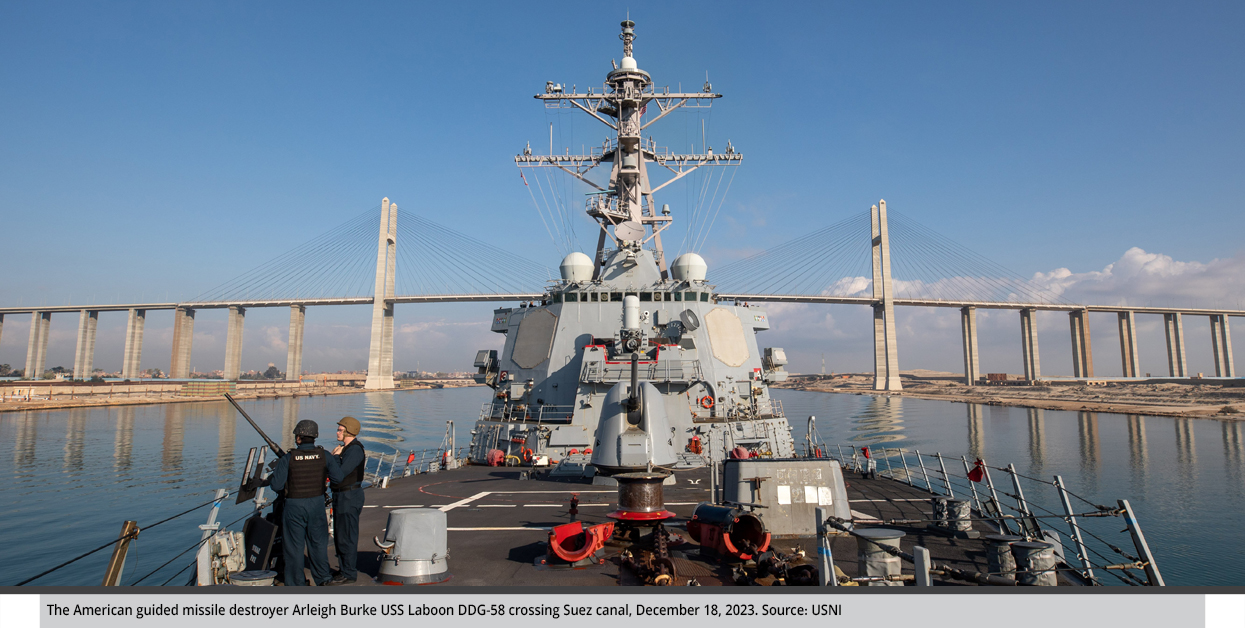Map of the Militarization of the Red Sea and the Features of Upcoming Conflicts
This policy analysis addresses the U.S. and Western military presence in the Red Sea in response to Houthi attacks. It also addresses several questions about the implications and motives behind the unprecedented military mobilization in the Red Sea. For instance, is it proportional to the scale of the Houthi threats to international trade?
by STRATEGIECS Team
- Release Date – Jan 28, 2024

The repercussions of the war in the Gaza Strip have now reached the Red Sea and the Bab al-Mandeb Strait. This region is experiencing an increased American and international military presence in reaction to Houthi attacks on Israeli and ships associated with it.
On December 19, the United States expanded the list of participants in the Red Sea by announcing the formation of an international naval force, Prosperity Guardian, that involves more than 20 countries. Alongside Britain, the United States has conducted a series of military strikes against Houthi targets since January 18, prompting questions about the implications and motives driving the unprecedented military mobilization in the Red Sea. Such as: Is it proportional to the scale of the Houthi threats to international trade?
The Western Military Presence in the Red Sea
The American and international military presence in the Red Sea predates the Gaza war by decades. In 2001, the United States established the Combined Maritime Forces (CMF) with allied countries and NATO. Led by Vice Admiral Brad Cooper, commander of the Fifth Fleet and the U.S. Naval Forces Central Command, the CMF stands as the world’s largest combined maritime force. It consists of five fleets:
- Combined Task Force 150, a Bahrain-based 25-nation coalition focused on countering international terrorist threats.
- Combined Task Force 151, formed in January 2009 to combat piracy.
- Combined Task Force 152, coordinates security operations in the Persian Gulf region.
- Combined Task Force 153, established in April 2022 to safeguard the Red Sea.
- Combined Task Force 154, established in May 2022 to bolster maritime security in the Middle East.
In 2008, the European Union launched EU NAVFOR (European Union Naval Force) Operation Atalanta to combat piracy in Somali waters with the participation of Spain, Germany, Sweden, Greece, Great Britain, Belgium, France, and the Netherlands. The operation included the deployment of six ships, three surveillance aircraft, and around 1,200 personnel.
In the run-up to the Gaza war, the United States increased its naval military presence in the region. In August 2023, more than 3,000 Marines, the amphibious assault ship USS Bataan, carrying more than 24 aircraft, and the amphibious transport dock USS Carter Hall, joined the U.S. Fifth Fleet in response to Iranian harassment of commercial ships at the time.
However, after the war in Gaza, the United States moved a large number of its naval vessels towards the eastern Mediterranean Sea and the Red Sea.
On October 10, the guided missile submarine USS Ohio joined U.S. Central Command’s area of responsibility. And on November 5, the strike group led by the aircraft carrier USS Dwight D. Eisenhower arrived in the Middle East, along with the USS Philippine Sea guided-missile cruiser, the USS Gravely guided-missile destroyer, the USS Mason guided-missile destroyer, and the Carrier Air Wing Three, with nine squadrons of aircraft. (The strike group of the aircraft carrier USS Gerald R. Ford was stationed in the eastern Mediterranean before returning to its base in the United States in early January 2024.)

With the launch of the multinational operation known as Guardian of Prosperity to counter Houthi attacks in the Red Sea, the participating countries reinforced their naval forces in the Red Sea.
Britain sent the destroyer HMS Richmond to join their HMS Diamond and HMS Lancaster destroyers that are part of the Joint Task Force 150, along with three minesweeping ships and a support ship tracking the British Royal Navy.
France has two ships in the region: the multi-purpose frigate Languedoc and the supply ship Jacques Chevalier. On January 25, France announced it is sending a third ship, the frigate Alsace.
Spain and Italy each have one ship in the region, and Sri Lanka has announced its intention January 10 to send naval ships to support Operation Prosperity Guardian.
The European Union is considering a formal proposal, discussed during their January monthly meeting in Brussels, to move a military force into the Red Sea, including destroyers, frigates, and early warning aircraft. According to Josep Borrell, the EU’s foreign policy coordinator, “Not all member states will be willing to participate but no one will obstruct.”
Red Sea Risks
In November 2023, the U.S. State Department’s annual report on terrorism pointed to the shift in U.S. policy from a central military approach to a diplomatic priority and the building of preventive capabilities for allies. However, shortly after the report’s release, the United States is working to enhance its military presence in the Middle East in response to the challenges accompanying the war in the Gaza Strip.
This is a sign that has its implications, which does not necessarily mean preparing for a large-scale military operation as much as it expresses the level of the U.S. and Western response to maritime threats at various levels, especially those related to piracy, the activities of armed groups, and terrorism.
Indeed, this intensive military presence comes as an expression of the geopolitical importance of the region in the conflict between the major powers, and the importance of the Middle East waterways—especially the Bab al-Mandeb Strait, the Suez Canal, and the Strait of Hormuz—in the global economic system. In light of this, the American objectives of its military presence in the region and the Red Sea can be focused on:
- China and Russia
The White House strategy for 2022 identified both China and Russia as serious challenges to U.S. national security and foreign policy in key the areas of influence around the world, including Europe, East and Southeast Asia, and the Middle East, specifically Israel and the Arab Gulf states.
Europe is a major arena of confrontation with Russia; East and Southeast Asia are a direct arena of confrontation with China; but the Middle East has become a battlefield for both Russia and China, necessitating the reinforcement of American military power in the Middle East, especially in strategically geopolitical areas like the Red Sea. The primary purpose of these actions is to assert control over oceans and high seas because controlling these offers a tightening control over the international system.
- Iran
Iran is one of the challenges facing the United States, with Tehran’s pursuit of developing its military, technical, and nuclear capabilities, and the use of its network of affiliated armed groups in Iraq, Syria, Lebanon, and Yemen against American and Israeli interests.
Iran has used the Yemeni arena to help reduce the pressure of the American military presence in the Mediterranean Sea on Hezbollah in Lebanon, and to disperse American power in a conflict geographically far away from Lebanon. The United States has sent naval, air, and ground reinforcements since the first day of the war in order to deter Iran and its groups from engaging in the Gaza war heavily, and to bring the Middle East into the midst of a complex conflict.
- Gaza Strip
The attacks of the Palestinian factions in the Gaza Strip showed the threats that non-state actors may pose, which often exceed their strength and size. This was a motive for trying to deter the Houthis from affecting international trade, and the possibilities of carrying out operations that could have long-term effects, especially by targeting petrochemical tankers or planting naval mines that threaten to disrupt shipping for years.

- Europe
The European economy is still in the process of recovering from the Ukrainian crisis that erupted in the spring of 2022, especially in the energy and gas sectors after Europe sought to reduce its reliance on Russia for energy supplies. With the attacks of the Houthis, European imports from Asia are threatened, especially oil and gas. By choosing alternative shipping routes through the Cape of Good Hope in South Africa, this leads to lengthening the route and increasing costs. Thus, European movements are specifically driven by managing navigation in that waterway due to the implications of its disruptions for their economies.
Consequences of the Militarization of the Red Sea
The increasing Western military presence in the Red Sea and the intention to intensify it in the future could lead to the “militarization” of the Red Sea, which would have a complex set of implications at near, medium, and long-term levels—not only for the Red Sea region but for the region and the world as well.
- Sino-American Competition
The intensified Western military presence in the Red Sea will reflect on the Sino-American competition. China sees that the conflicts strengthen the influence of the United States at the expense of China’s soft expansion, which relies on stability and economic aspects.
In addition, China is concerned because it believes that the United States is trying to fuel tensions in the Red Sea in order to surround its “Belt and Road” initiative, which uses the Red Sea as a meeting point between the land corridor and the maritime Silk Road, and to narrow down its only overseas military base in Djibouti.
- United States and Iran
The intensified military presence in the regional seas and straits could lead to their return as arenas of confrontation between the United States and Iran. Those military reinforcements and attacks against the Houthis have been criticized by Iran. In fact, before the formation of the “Prosperity Alliance,” Iranian Defense Minister Mohammad-Reza Ashtiani warned that any international force to protect navigation in the Red Sea would face major problems in conjunction with the unveiling of the Islamic Revolution Guards Corps’ shadow naval force operated by the Basij, a voluntary paramilitary unit trained to carry out marine military operations.

The wide spread of the groups it support gives Iran the ability to create a more complex and dangerous military theater for regional security, extending the instability to the Mediterranean Sea and even the Arabian Sea.
- Arab Nations
Any conflict in the Red Sea will lead the region to a new phase driven by regional and international competition that will have an impact on Arab countries in terms of their political, economic, and security interests, especially countries that have coasts on the Red Sea.
On the one hand, stability in the Red Sea is a cornerstone of Arab economic stability, especially Saudi Arabia, which is seeking to diversify its economy away from oil through the implementation of Vision 2030’s strategic projects overlooking the Red Sea, including creating the city of Neom and the projects of the Red Sea International Company owned by the Public Investment Fund, which develops the tourist fronts of the Red Sea.
As for Egypt, the Bab al-Mandab Strait and the Red Sea are a key passage for the Suez Canal, whose revenues constitute one of the main sources of the Egyptian economy, especially in terms of hard currency. The repercussions also extend to the Arab regions overlooking the Israeli city of Eilat, especially the Jordanian city of Aqaba and its port, and the Egyptian cities, which are important cultural and tourist fronts for the two countries.
- The India-Middle East-Europe Economic Corridor
Regional stability and maritime security are key factors for completing the plans related to the economic corridor that was launched and signed in September 2023 connecting India to Europe and passing through the Middle East. As the Red Sea is moving towards becoming a military environment of tensions and regional and international clashes, this may have repercussions on the Strait of Hormuz and the Arabian Sea, which could put the project at risk.
- Horn of Africa Region
The surrounding environment in the Red Sea is suffering from several disturbances. In addition to the threats emanating from the Houthi-controlled areas in Yemen, the Horn of Africa region is facing long-term challenges and conflicts, the latest of which is the conflict in Sudan, which has reached the city of Port Sudan overlooking the Red Sea. Its ports enjoy a competitive advantage regionally and internationally, especially with the attempts of Turkey and Russia to develop them and build naval military bases there. With the failure of the Saudi-American efforts to resolve the crisis in Sudan, the Sudanese shores on the Red Sea will remain weak flanks that threaten the security of the that sea.
- Yemeni Crisis
The repercussions of the instability in the Red Sea are reflected negatively on the future of Yemen, specifically on the political process aimed at resolving the Yemeni crisis. Through their attacks, the Houthis seek to achieve legitimacy and local popularity that will give them negotiating power or facilitate the expansion of their areas of control militarily, especially as they are trying to stir up popular anger over the weak position of the internationally recognized Yemeni government towards the war in Gaza. Moreover, America’s designation of the Houthis as a terrorist group obstructs Saudi efforts to negotiate with them for a settlement that resolves the Yemeni crisis, as the issue of negotiating with a group classified as terrorist is considered to be highly sensitive.
In conclusion, the threats resulting from the intensification of the militarization of the Red Sea and the escalation of conflicts within it and its surroundings are almost limitless. Their effects may go beyond the regional countries and cause international repercussions, especially at the level of the fierce scramble between the great powers to expand their influence in global trade and projects related to the Red Sea.

STRATEGIECS Team
Policy Analysis Team
 العربية
العربية